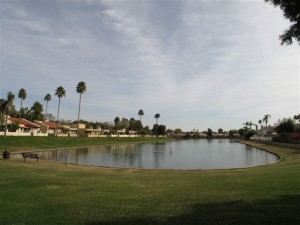by Paul Slaybaugh | May 1, 2009 | Home Buying, Scottsdale Real Estate
In typical Real Estate marketing, an agent directs efforts towards selling either a product or his/her services. In turn, that is how most professionals gear blogging habits. We post our listings and promote ourselves as buyer and/or seller representatives. One avenue that is lightly explored, however, is the direct marketing of our buyers to sellers.
Given the sheer immensity of active inventory in many markets throughout the country, the art of mating buyer with property is not always as refined as it could be. For example, we have about 40,000 listings currently on the market in the metro Phoenix area. With that raw volume of choice, it is almost incomprehensible that the right property will not be among that throng. As such, common practice would dictate an agent send the prospect the best 10-20 options, show the prospect their favorite 8-12, select the prospect’s top three choices, make an offer on the favorite, move down the line if acceptable terms are not met until you strike a deal. Easy.
While great in theory, I find this method works far better for the investor than the user. There are bargains to be had all over the market, but value is only one part of the puzzle for the person who will use the home as a primary residence. Especially true of someone who does not want to do much, if any, fix up, an agent is often left with far fewer viable options than would ever be conceivably possible in such a strong buyer’s market. There’s just a lot of junk to sift through, quite frankly.
I have several clients who have been looking off and on for that perfect house for well over a year. These aren’t folks who demand to see property every week, but ones who will act if and when the perfect confluence of wants/needs appears. There is absolutely no pressure to buy, and they will essentially move when they are forced to by the manifestation of the perfect home.
For such buyers, trawling the MLS for new listings is the first, and unfortunately, only step that many agents will take. The search will become staler and staler until it vanishes into cyberspace altogether, lost in the apathetic binary code of a decreasingly motivated agent.
There is a more proactive route that an agent can take for such hard-to-place buyers. As enterprising agents have mailed or door-knocked communities in years past to drum up candidates for the discriminating buyer, we can use our blogs to canvas the internet. With our postings reaching into inboxes all across the communities we serve, relying solely on the MLS for inventory is antiquated.
Think about it. What is the first thing a homeowner will do when mulling the notion of putting his home on the market? While we agents would prefer they fetch our calendar or business card and call us immediately, the truth of the matter is that they will sit down at the computer to do a little amateur detective work. In doing such research, they will plug in certain defining aspects of their homes.
If I have already posted a buyer need for a client that wants a 4000 square foot home on an acre in the Chaparral School District in Scottsdale, Arizona for up to $1.2 million, a potential seller of such a property very well might find me before I find him.
Google is a beautiful thing.
So while we continue to place our listings all over the internet for buyers to find, we shouldn’t lose sight of the power of the internet for drawing out the owners of unique properties as well. I would certainly expect a receptive response from the homeowner who is not too keen on a lengthy and uncertain stint on the open market. A one-shot showing to a qualified buyer would have to sound quite appealing to a seller right about now. No accumulation of days on the market, no long-term commitment … it could be just the tonic for the thirsty would-be seller who has been leery of putting a home on the market in the current environment.
Buyer Touts: They’re not just for office meetings anymore!
So about that 4000+ sq ft home on an acre in Scottsdale or Paradise Valley for up to $1.2 million … my clients prefer newer construction. We’ ll be awaiting your call.
And for all of you frustrated buyers out there who can’t find that unique home you are looking for, send me a list of your wants/needs (just please don’t tell me you want to be on Camelback Mountain for $250,000) and I’ll flood Google with your criteria. Who knows? The owner of your next home just might need a little coaxing to come out of his cave and bask in the brilliant glow of a qualified buyer.
Consider me your reverse Scottsdale/Phoenix MLS!
by Paul Slaybaugh | May 1, 2009 | Scottsdale Real Estate
My buyers must think that I am an absolute buzzkill sometimes.
How can an agent possibly find something wrong with 25 straight houses?
Why would a Realtor always harp on the negative instead of getting excited about the positive?
This market is why.
When I am working with buyers, I tend to point out every conceivable flaw with each property we visit. I have literally talked clients out of purchasing homes. Be it a busy street, a vacant lot next door with suspect zoning, goofy architecture, etc, I am ruthless. An anti-salesman if you will. Not only does this give me credibility when I actually do show some excitement about a property that I think is a terrific value, but it protects the buyer’s future interests. Inside every good buyer’s agent is a listing agent. I know that someday I will be called upon to sell the home that my clients are buying today. Out of pure selfishness, I want to make sure I have a saleable listing. That means great location, great condition and great price. This brings my goals in perfect alignment with theirs. An agent who focuses only on today’s sale cannot be trusted to secure the best value and highest possible appreciation schedule. Many agents will spend thousands of dollars soliciting the listings of highly desirable properties. I would rather secure great listings by finding my buyers great houses.
And in a difficult market like today’s, the last thing I want is to tell a client that his/her home will be darn near impossible to sell because of some flaw that we overlooked. Or that there is not much wiggle room on price because we did not secure the best value. While many properties are sitting on the market, the good ones are selling. The lesson to be learned is that the pain many sellers are experiencing right now is not entirely market driven. Some blame must be levied for purchasing with rose colored glasses, and not being nearly critical enough when assessing the property.
So for the foreseeable future, you will see me with a smile on my face most all of the time … except when showing property.
by Paul Slaybaugh | May 1, 2009 | Home Selling, Scottsdale Real Estate
In today’s topsy turvy Real Estate market, many potential players have been scared to the sidelines. Whether it be the buyer who worries that prices will continue to plummet across the boards, or the seller who laments the inability to fetch the same price that was attainable a year ago, there is a lot of market watching going on right now. To be sure, these are unusual times. Before you let the condition of the market at large dictate whether or not you buy or sell Real Estate, though, bear in mind that there is opportunity amidst chaos. Just as the worst investments are often made in the best of times, the best investments are often made in times such as those we are experiencing today.
We all know that buying low and selling high is the name of the game. The difficulty comes in recognizing the apex and the nadir. If it were really doable, we’d all be billionaires. As this determination is only truly made in hindsight, the key is to make the current market work for you, rather than standing around and waiting for the mythical “bottom” as a buyer or “top” as a seller.
So, how does one not only survive, but thrive as a consumer in this tough market? By making purchasing and selling decisions based upon a comprehensive strategy rather than treating each as isolated transactions. Assess your situation, and decide whether the current market will provide enough positives to offset the negatives. Here are a few such strategies that just might make a move feasible after all.
The Move Up Purchase:

The move up buyer is tailor made for this market. Provided that you are looking to stay within the same market, if home values in your area have declined by 10% (purely arbitrary figure), that larger home that you have had your eye on is closer to your reach than ever. If your $300,000 home took a 10% hit, and the $500,000 home of your dreams took a 10% hit, the value difference just shrunk by $20,000 (30k versus 50k in depreciation). Such homeowners need to stop considering themselves as sellers. They are buyers in sellers’ clothing. That too-small home is all that stands between you and the tremendous deals that are available today. Price it right, take your lumps, and you will free yourself to go give somebody a few lumps of their own.
The Downsizing Scenario:
Downsizing to a smaller, less expensive home does not make good financial sense in this market. The factors which work to the consumer’s advantage in the scenario above work to the detriment of the consumer here. But what about the retired couple who doesn’t want to wait for the market to rebound? One way to get on with their lives without taking it in the shorts by selling right now is to consider leasing the home. Assuming that many people in this position will have a substantial amount of equity in their homes, they might even be in a position to draw a positive cash flow by renting out their existing home. They would also be in a position to draw down payment funds for the home they wish to purchase in the form of a home equity line of credit (HELOC). This is about the only scenario in which I would entertain the notion of drawing equity out of a property right now. I have spoken with a few retirees lately who wish to downsize, but don’t want to sell in the current market. I don’t blame them one bit. Putting a tenant in their homes until the market is more conducive to commanding a more attractive sales price may be the way to go.
A More Battered Local Economy (AMBLE):
For the person moving completely out of area, it wouldn’t appear to be a very attractive proposition. You get hammered on the selling end without getting to reap the rewards on the buying side. So what to do? Move somewhere that has gotten hit even harder by the depreciation bug than your community. I admit, this is really more flippant than realistic, but if there are job transfers, family, etc. waiting in hard hit parts of the country, you can conceivably offset the low sales price of your current home with a lucrative buy.
INVEST, INVEST, INVEST!

 Along with the move up purchase, this is the biggest no-brainer going. With bank owned property listings, inflated inventory levels and a buyer pool diminished by tightened lending requirements, there has not been a better time to be a buyer since the Gadsden Purchase.
Along with the move up purchase, this is the biggest no-brainer going. With bank owned property listings, inflated inventory levels and a buyer pool diminished by tightened lending requirements, there has not been a better time to be a buyer since the Gadsden Purchase.
While the resale market at large may have further to fall in value, there is really nowhere left to go for some of the bank property bargains I have encountered lately. There is significant demand for the low end of the price spectrum, with multiple offers, cash buyers and bidding wars in some instances. So when you hear that prices may fall another 10-20% across the board, it’s not going to be on the steals. These properties may pull values down closer to them, but there is too much demand for the low end to keep falling in my humble opinion. There are great values in land right now as builders have basically shut down until they sell off existing inventory. Single family homes are attractive to many as a tenant can largely offset carrying costs. It is a great time to have a few extra bucks in your jeans if Real Estate investment is in your blood.
There are more creative avenues to be explored in this market, but for the purposes of this post, I’ll stick with the basics. The bottom line is that you can benefit from the current market with the right strategy. Money is not only made by tucking more in your jeans, but by taking less of it out as well. There is no such thing as a “BAD” market, nor a “GOOD” market. There is only the market. It’s up to you to bend it to suit your purposes.

by Paul Slaybaugh | Apr 30, 2009 | Home Buying, Scottsdale, Scottsdale Neighborhoods

Lake Margherite in McCormick Ranch
Water is a precious commodity in the desert. Dependent upon the CAP (Central Arizona Project) and SRP canal systems to fill our taps and water our lawns with the liquid gold of the Colorado and Salt Rivers, we do not squander our lifeblood frivolously … with the notable exception of Slip-N-Slide Saturdays, of course. Given the grand total of naturally occurring lakes in the Valley of the Sun stands at exactly zero, we denizens of the creosote jungle are drawn to a droplet of water like mercury to the top of a Sonoran thermometer. We weekend at Saguaro Lake or Lake Pleasant. We make semi-annual pilgrimages to the sandy beaches of southern California. We float the Salt River amongst a throng of Memorial Day humanity that is equal parts Coppertone and the AC/DC Back in Black album. We secretly adore the rains that the summer monsoons bring.

Given our propensity to flock to that which is scarce, waterfront communities are highly desirable locales in the greater Scottsdale area. There are few communities within the boundaries of the West’s purportedly Most Western Town that boast lakes on the list of amenities, and there is a reason for that.

When McCormick Ranch was originally developed in the 1970s, it was to be the first master planned community in Scottsdale. Believe it or not, the Hayden and Indian Bend Rd intersection (where initial development of McCormick Ranch began) was considered North Scottsdale at the time. There was really nothing else around. To lure skeptical home buyers away from the downtown Scottsdale area (what we now refer to as “Old Town”), developers threw the entire kitchen sink at them: parks, greenbelts, walking paths, golf course and lakes. Including Lake Angela, Lake Nino and the crown jewel, Lake Margherite, the community is a veritable desert oasis.
When Scottsdale Ranch was developed a decade later, planners adhered to many of the same guiding principles. East of McCormick Ranch, it was built around a lake system, walking paths and parks in much the same fashion. Once again, developers knew they needed to give people a reason to venture a little off the beaten path to buy their product. They were selling a lifestyle as much as housing. That lifestyle revolved around a meandering 42 acre waterway by the name of Lake Serena.

Flash forward a couple of decades and developers, by and large, stopped providing such extravagant amenities. The area had become well established and new residents came in droves. Land values shot through the figurative roof and builders saw no literal need to plop a man-made lake down on a parcel of land that could instead be used to build and sell another 100 or so more houses.
As such, there are relatively few waterfront options in Scottsdale outside of these two master planned communities. They just don’t build’em like they used to. While properties along the water in both developments are typically quite expensive, there are patio home and condo options that fit less extravagant budgets. To help you get started with your waterfront search, following is a compilation of lake subdivisions located within McCormick Ranch and Scottsdale Ranch.
*You may wish to bookmark this page as each subdivision name will eventually include a link to detailed descriptions and current active listings. It’s a work in progress.

McCormick Ranch
Vista Del Lago
Island At McCormick Ranch
Palo Viento 1
Heritage Village
Las Palomas
Scottsdale Ranch
Landings at Scottsdale Ranch
Las Brisas
Lake Serena Estates
The Bay Club
Lakeview Estates
Bayview Estates
Waterfront
Monterey Point
Charter Front
For less costly options that are near the water, but not necessarily located right on it, there are a few older neighborhoods further South (closer to Old Town) that abut Chaparral Park. While the homes (and townhomes) in the area are far removed from the luxury market, it is a great option for those more concerned with location and amenities on a shoestring budget. For high end townhomes, there is the Scottsdale Waterfront option along the canal banks in downtown Scottsdale (Old Town). Pages dedicated to these neighborhoods will be added to the site over the coming weeks as well.

The right Scottsdale waterfront property is out there. We’ll help you find it.
Contact Ray & Paul Slaybaugh today to start the search for your Scottsdale AZ waterfront home!
(480) 220-2337 | paul@scottsdalepropertyshop.com
by Paul Slaybaugh | Apr 17, 2009 | Home Buying, Scottsdale Real Estate
Times were you looked at a few houses, found one you liked and made an offer to the current owner. After a bit of haggling, you settled on a price that both parties could live with and away you went. Easy as pie.
In the current landscape, however, buying a home is not always that simple. Due to the prevalence of foreclosure properties and upside down sellers in today’s market, a buyer is often in the dark as to the nuances that may vary from one property to the next. To that end, there are certain rules of thumb that a buyer should keep in mind as he or she navigates the 2009 Scottsdale Real Estate market.
1. The Short Sale Property

"Upside down, boy you turn me, inside out ..."
You’ve read about them in the paper, heard about them on the news and know somebody who attempted one, but still may not know exactly what a short sale is. First off, I would be remiss if I didn’t make the requisite quip that short sales are anything but short. By and large, they are loooooooooooooooooooooong.
The term “short sale” is derived from the seller’s lack of equity in the property. In fact, the seller is upside down to the point that the market value of the home is less than what is owed on the mortgage(s). With a short sale, the seller must convince the bank to take a loss by agreeing to the sale. There are numerous pitfalls, including waiting for weeks or months for the lienholder’s response and low success rates (less than 10% of short sales are successful). One particular difficulty lies in ascertaining whether a seller even qualifies for a short sale at any price. Each institution has its own unique standards, but sellers must adequately demonstrate hardship (job loss, etc), provide up to date financial statements and pay stubs, document where all funds for a line of credit have gone (the lender in 2nd position will disallow a short sale if the funds went anywhere except back into the house (kitchen remodel, pool, etc). The biggest saboteur of a short sale, other than an incompetent listing agent, is the presence of a second loan. Multiply the difficulty exponentially if the loans are held by different institutions.
If it sounds like a lengthy, treacherous process, that is because it often is. Short sales, in this agent’s humble opinion, only make sense for the buyer with no real time table. Investors, specifically, are primed to take a stab at one if the purported price (the price listed in the MLS is really just a moving target when you don’t know what the bank will ultimately deem acceptable) is attractive enough. If you don’t plan to live in it, and won’t be devastated if it doesn’t pan out, have at it.
2. The Foreclosure Property

I'll take a single-family home and $20 cash back, please
If 2009 could be summed up by initials, they would be “REO.” Real Estate Owned properties, or foreclosures, are all the rage this season, and for good reason. Banks are awash in foreclosed homes at present and have effectively set the market. Eager to rid themselves of bloated inventories, the various institutions have well-earned reputations for bargain basement pricing. By the time a bank takes a property back from an owner in default via a Trustee’s Sale, I find they are often ready to deal. If the short sale process can feel like a rudderless vessel as your offer drifts from file to file in the bank’s loss mitigation department, there is actually a captain at the helm by the time the bank ultimately rejects the offer(s) and opts to foreclose instead. Now an asset manager is responsible for offloading the acquired property. Just the titles alone speak volumes as to the motivational forces at play:
loss mitigation VS asset management
More often than not, a property that is taken back by the bank will reemerge as an REO property at an even lower price than the listed price of the failed short sale attempt. Does it make sense? Not really, but that’s what often happens. And the price is no longer a moving target. With the bank now the principal, they set the list price and will negotiate more like a typical seller (albeit at a slightly slower and more aloof pace). Expect to wait up to a week for a response and the possibility of fighting off multiple offers due to the low pricing, but it sure beats waiting months for an all too often unreasonable response.
The negatives of dealing in bank-owned property are primarily rooted in lack of disclosure about the home and the penchant for selling property “as is.” You can be sure that something will be missing from the home. Either vandals have cannibalized the A/C for copper or the former owner yanked all of the appliances and the hall bath towel rack out of the home on the way out, but rest assured, some component of the house is FUBAR. Complete with heavy handed addenda that favors the seller, the trade off for the great price on a bank property is an often uncared for home with no disclosed history of damage/repair and no one to repair the defects you find during the course of your due diligence period.
Yes, you do get the opportunity to inspect even though the bank will require an “as is” addendum. If you ever see language in a contract or addendum disallowing your right to inspect the property … run!
3. The Resale Home

Quick, Marge, get the camera ... real people!
Ah, a home actually owned and sold by a real, unencumbered person. I must confess, finding such a specimen in the modern Real Estate jungle has been a rarity. At least finding one that can compete with the pricing of bank-owned homes, that is. As more and more sellers become realistic about the erosion that has taken place in Valley home values, though, I am starting to see the gap close ever so slightly. Obviously, anyone who bought a home in 2005 or later is not in a position to competitively price it for today’s market without attempting a short sale due to the subsequent swan dive in prices, but those who have been in their homes for a decade or longer are finally getting the memo and positioning themselves to compete with the banks. With prices still trending downwards, the smart seller is getting out in front of the curve and pricing his/her home to sell before any further price degradation can occur. When you find such a home with a seller still capable of maintaining, disclosing and repairing the property’s condition, and priced in line with the foreclosure market … buy it!
So there is a (not so) brief synopsis. Don’t limit yourselves unnecessarily when shopping for a home. Allow your agent to explore all available avenues, just be aware of what you might be signing up for with the entanglements that come with each option.
Most importantly, remember this: A low price in the absence of value is meaningless.



 Along with the move up purchase, this is the biggest no-brainer going.
Along with the move up purchase, this is the biggest no-brainer going.









